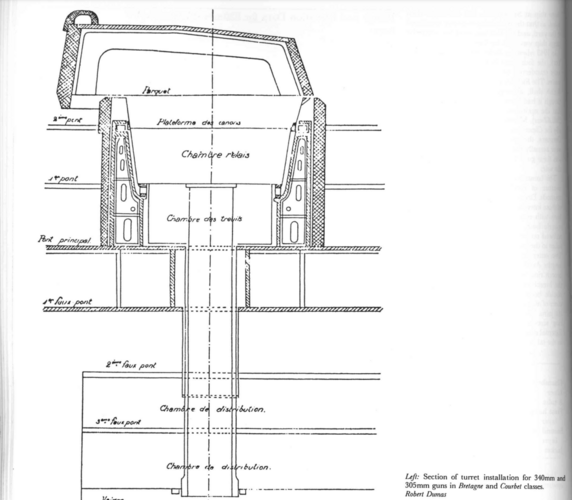This thread is organized by ship type when information is available, and includes general plans when unavailable. It starts with Destroyer plans, moves to Battleship plans, then to Cruiser plans, and finally to Aircraft Carrier plans, followed by lists of various war demands and fleet building plans. Image backups can be found here: https://drive.google.com/drive/folders/12pKLsTMiEsHTs_CsK2vAbn-bB1ICH_jJ
Destroyers
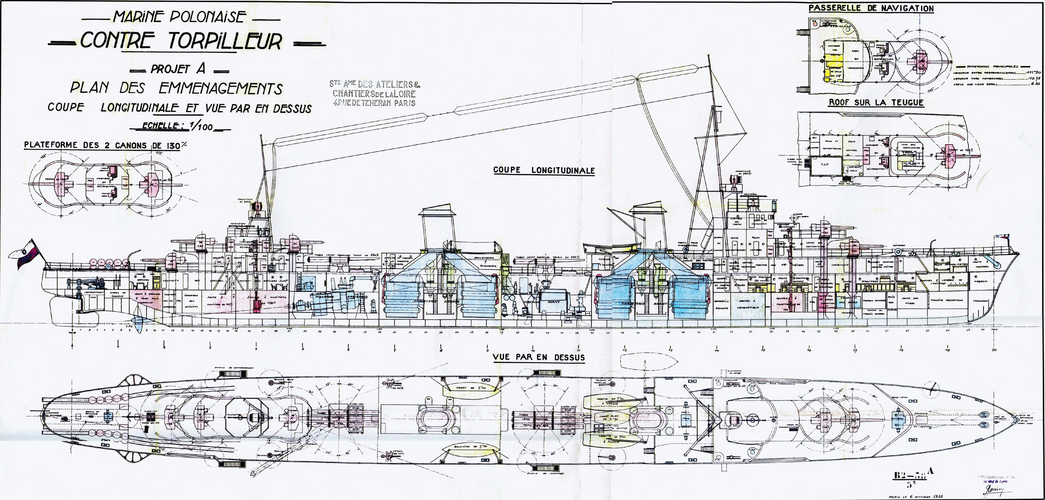
Ateliers et Chantiers de la Loire Proposal
Modified Le Fantasque. 5x1 130mm [40 caliber Mod. 1924, as in Burza and Wicher], 2x1 40mm on the main deck, one on each side behind the rear funnels, 2x2 Hotchkiss 13.2mm MG, with one on each side by the bridge. 550mm torpedo tubes in 2 triple mounts
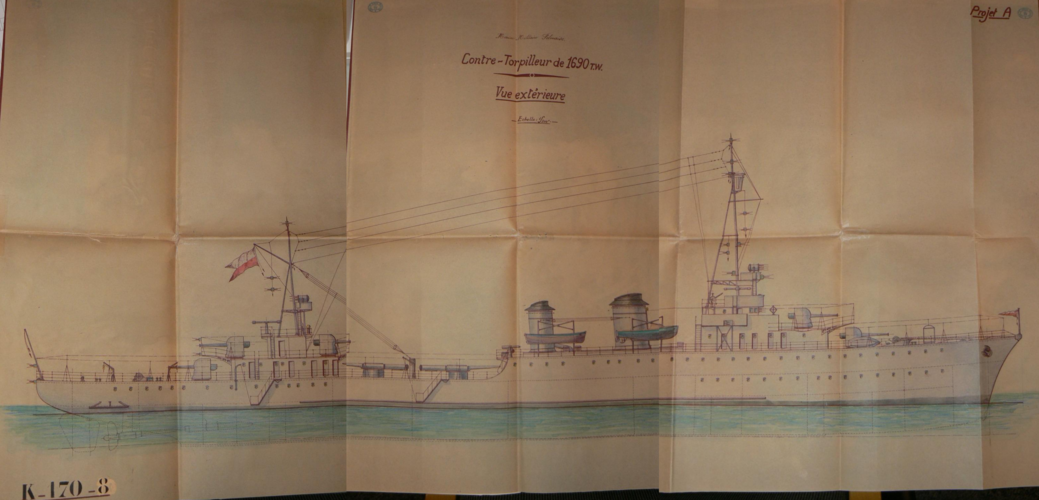
Normand Shipyard Proposal
Modified Guepard. 5x1 130mm [40 caliber mod 1924], 2 single pompoms behind the second funnel, 2 Hotchkiss twins on each side of the rear tripod, 2x3 550mm. meant to make 36-38 knots
![Copy of [1934] Thornycroft T976A.jpg Copy of [1934] Thornycroft T976A.jpg](https://www.secretprojects.co.uk/data/attachments/203/203448-2da62b431833cafabc3a223d8e245359.jpg)
Thornycroft T976A
3x2 120mm [Bofors], 2 40mm between the funnels. 2x3 550mm
![Copy of [1934] Thornycroft T977A.jpg Copy of [1934] Thornycroft T977A.jpg](https://www.secretprojects.co.uk/data/attachments/203/203449-e41937e7108e40330a1d2f4d7c73e0c5.jpg)
Thornycroft T977A
3x2 120mm [Bofors], 2 40mm between the funnels. 2x3 550mm. slightly downsized version of T976A
![Copy of [1934] Thornycroft T978A.jpg Copy of [1934] Thornycroft T978A.jpg](https://www.secretprojects.co.uk/data/attachments/203/203450-18c3f2858cdb3c4a0d9286a7ed99ae6e.jpg)
Thornycroft T978A
(composite image isn't good, c'est la vie)
Same hull as T977A, rearranged masts.
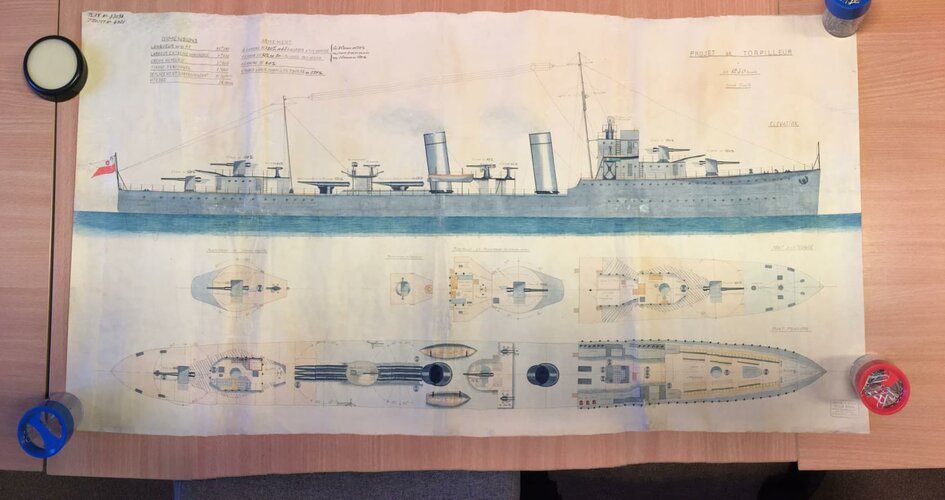
Normand Shipyard Proposal
4x120mm/45, 1x1 76mm/50 AA, 3x2 40mm AA, 2x3 550mm
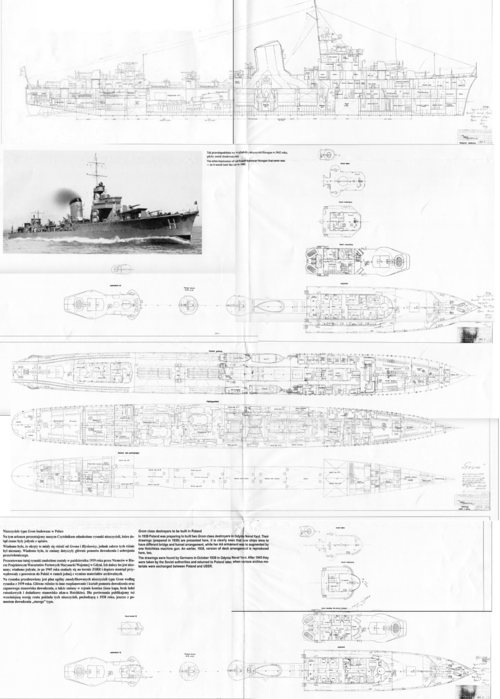
Huragon
Versions of the Blyskawica class to be built domestically in Poland. Slightly different internal arrangement, redesigned bridge and funnel, and another Hotchkiss MG superfiring above the 40mm Bofors behind the funnel.
Wallsend Shipyard design.png
 drive.google.com
drive.google.com
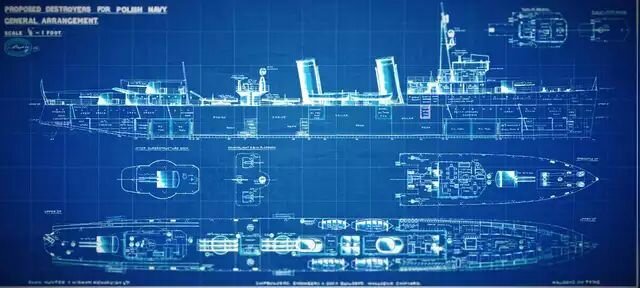
Wallsend/Swan Hunter design
3x2 120mm, 2x1 40mm Port and Starboard on the searchlight platform.


Wicher/Burza Modernization
Detailed in Warship Volume IV, this was a planned modernization for Wicher and Burza to standardize armament and profile with the Grom and Blyskawica. They would have carried 5 120mm guns, with the twin in Y position, 2x2 40mm on platforms like the Grom's, and 4?x2 Hotchkiss 13.2mm MGs. They would have kept the 550mm TT and DCRs.
Battleships
"The matter of handing over the American battleships to the Polish Navy was raised only by Jerzy Pertek, who - citing the memoirs of Comdr. Władysław Kosianowski - only outlined the draft of one of the American senators to donate six ships to Poland. However, it did not explain the reasons for the application or the reasons for the rejection of the proposal. The answers to these questions can be found in the documents stored in the Central Military Archives in Rembertów and the Archives of New Records. The sources of the entire history can be found in the events of February 1922, when the Disarmament Conference ended in Washington. , The British Empire, France, Italy and Japan of the treaties on the limitation of armaments at sea. 6 Connecticut type, 5 Virginia type and two Maine type. In connection with their withdrawal from service in the US Navy, the Republican Senator of the State of Maryland - Joseph Irwin France presented a bill on July 5, according to which the President of the United States (Republican Warren G. Harding) would be authorized to hand over to the Republic of ships that - according to the Washington Treaty - they were scheduled for deletion from the lists of the American fleet. " I can write this about the Chilean ship: In 1931, there was an offer to sell the Chilean battleship Almirante Lattore to the Polish Navy. Ultimately, nothing came of it. Also in 1931, the sale of the Spanish-class battleship Espana was offered to Poland, the battleship Espana later renamed Alfonso XIII, and in the same year there was also an offer for a Spanish armored-deck cruiser and a submarine. I read about the fact that Poland was interested in the Revenge battleships on secretprojects.com in the topic of project 1047.
Sources:
https://www.magnum-x.pl/artykul/okrety-ktore-nie-podniosly-bialo-czerwonej-bandery
https://www.magnum-x.pl/artykul/polskaeskadrapancernikow
Graf Spee (1919)
SMS Graf Spee was a Mackensen-class battleship being build in Gdansk while it was part of the German Empire. The ship was eventually scrapped in 1921-1922. No plans to complete it are currently known.
Gangut-class (1921)
As part of the treaty ending the Polish-Soviet War, the Poles originally demanded 2 Gangut Class Battleships. However, they received no naval reparations from the treaty.
25,000t BB (1939)
By 1939, the naval plans had been changed to include small 25,000t battleships. These were planned to have 3x3 305mm, 4x3 152mm, numerous AA guns, 2x3 Torpedo tubes on the deck, as well as 4 shafts outputting 120,000-140,000 SHP for a speed of 30 knots. The maximum armor thickness was planned at 350mm, and the planned cost was 162.5m PLN. The requirements would have been far too much on that displacement, but no more design work is believed to have occurred. (Breyer)
Cruisers
Danae (1920)
Before the Polish-Soviet War, the newborn Polish fleet was to receive cruiser Danae. However the British reneged on this deal due to not liking the peace brought at the end of the war between the Poles and Bolsheviks
Duguay-Trouin (1926)
In 1926 the "small program" of the KMW (the maritime direction) announced over 12 years the commissioning of 2 cruisers, 6 destroyers, 12 torpedo boats and 12 submersibles, to be completed by 1940. The cruisers were to be copies of the Duguay-Trouin, built in Polish yards. Due to the dissatisfaction with the French yard CNT, which was building the Burza and Wicher, as well as an economic downturn, the cruisers were not realized.
Japanese Offer (1930)
The Japanese offered some vintage cruisers to Poland in July 1930. The ships offered were:
- Tone (1907), a unique armored cruiser
- Chikuma, Hirato, and Yahagi, the last protected cruisers of the Japanese Navy
- Tama, Kuma, Oi, and Kitakami, light cruisers meant to lead destroyers
- Tatsuta and Tenryu, smaller and less capable Kumas
Potyrała Washington Heavy Cruiser (1930)
Engineer Aleksander Potyrala proposed a Washington-style cruiser in 1930, mainly as a thought experiment. Characteristics as follows:
Length: 185 m Draft: 6m
Armament: 9x203mm, 9x120mm in a 9x1 arrangement, several AA mounts. 8 533mm torpedo tubes
Engine: machine power of 120,000 KM
Speed: 35 knots
Armor: 110mm belt, 90mm turrets, 40mm deck, 200mm Conning tower. Estimated construction value of approximately PLN 70 million.
Pocket Battleship Counter (1931)
In 1931, when the general data of the so-called pocket battleships was available, the construction of a 14000t cruiser was proposed by the KMW main staff. No work on such a design is currently known to exist.
Mine Cruiser (1936)
The 1936 plan included a 4,500 ton, 35 knots, 8 x 120 mm armed minelaying cruiser.
Aircraft Cruiser (1936)
An Aircraft Cruiser was provided for in the same plans: 4500 tons, with 8 152mm guns, and 35 knot speed. Eventually it became a design of 6000 tons, 8 152mm, 12 102mm, 12 seaplanes, 2x3 533 TT. No other information is known.
Other Pre-War Cruiser Plans
- The naval plan for 1936-1942 provided for 1 heavy cruiser that would be faster than pocket battleships and more powerful than German light cruisers, estimated displacement at 15,000 tons and a speed of 33 knots. After the reduction, this was abandoned. Displacement: 15,000 tons; Armament: 203mm; Speed: 33 knots; Engine with a capacity of 120,000 hp
- Naval Plan 1936/1937 called for 2 heavy cruisers (10,000 tons) with 3x3 203mm, 9 120mm guns, 2x4 torpedoes, 100,000hp engine, 200mm maximum armor
- Potyrała proposed another heavy cruiser in 1937, with similar characteristics to his other proposals
- Plans for an 8000t CL were apparently developed before the war, and such a ship was ordered directly before the war, apparently from the United Kingdom. However, no information is known to exist about the ship, as Vickers' customer records for the period and the Polish archives are incomplete. This is mentioned in "Plan M".
Aircraft Carriers
CV 1930
In 1930, a maritime program was drawn up which included a small aircraft carrier. No other information is known.
Casablanca-class (1945)
In April 1945, head of the Navy, Vice Admiral Jerzy Świrski, sent to Maj. Gen. Marian Kukiel, head of the Ministry of National Defense, developed by the KMW Planning Department, a long-term plan for the expansion of the Navy. What was the result of this long term [15 years] plan? Gaining full domination
on the Baltic Sea. It was very unrealistic, but appears to assume a war against the Soviets quickly followed by a return to pre-war 'normalcy'.
With the knowledge of the power of shipborn aviation, the plan included (with British help):
549 aircraft in the following lineup:
a .. 5 long-range reconnaissance squadrons (45 seaplanes);
b. 1st long reconnaissance squadron (24 four-engine land planes);
c. 4 long-range torpedo squadrons (96 aircraft);
d. 3 on-board torpedo squadrons (72 aircraft);
e. 6 on-board fighter squadrons (144 airplanes);
f. 4 squadrons of single-engine fighters (96 aircraft);
g. 3 squadrons of twin-engine fighter planes (72 aircraft).
and over 10,000 people in this formation. What is most interesting, it was postulated to create on-board aviation, the Poles were to obtain 6 escort aircraft carriers of the "Casablanca" type
[length 156 m, width 32.9 m, draft 6.3 m, maximum speed 19 knots, range 10 200 nautical miles at a speed of 15 knots, crew of 860 seamen, armament 1x 127 mm, 8 x 40 mm, 12 x 20 mm , 27 aircraft].
Hosho (1944)
Adm. Swirski planned for the takeover of IJN Hosho in 1944. How he thought this would be accomplished I have no idea.
Polish-Soviet War Demands
Prior to the commencement of negotiations with Soviet Russia in September 1920, several options for recovery of the Russian fleet were developed, which were to be used by the Polish side in the negotiations:
Initial variant I (from April 1920) - all cruisers, Bogatyr and Bajan, all destroyers, Lejtnant Belli, Lejtnant Iljin, Braczesław, Fiodor Stretiłat, Priamysław, Mieczysław, Sokoł and Nowik, all submarines, Tigr and Pantera , auxiliary Oka and Borgo
Variant II ("maximum") - 2 battleships, Sevastopol (23,000 t each), 10 destroyers, Mieczysław (1250 t each), 5 submarines, Pantera (800 t each), 10 trawlers 600 t, 2 ships auxiliaries Oka and Borgo (total 7,000 t) = 75,500 t; in addition, ships under construction (2 cruisers t. Svetlana, 7,000 tons each) and 4 heavy-caliber cannon turrets with ammunition and infrastructure, 16 naval guns of 100 mm with a reserve of 150 rounds per barrel, 2000 marine anchor mines and torp nets.
Variant III ("minimium") - 5 destroyers, Mieczysław (1250 t each), 5 submarines, Pantera (800 t each), 5 trawlers 600 t, 1 auxiliary Oka (2000 t), 1 "oil ship "(tanker?) a 1,500 t = 16,750 t; in addition, the cruiser Svetlana (7,000 t), 2 ships of 8,000 t, 7 cannon turrets, 16 100 mm guns and 1,000 mines, is under construction.
Post WW1 Demands
1st variant from Germany: 1 battleship t. Kaiser (24 700 t), 1 battleship t. Moltke (23,000 t), 3 cruisers t. Pillau, Graudenz, Regensburg (4900 t each), 6 destroyers 1500 t each, 7 torpedo boats 600 t = 75,600 t
Variant II from Germany: 1 battlecruiser t. Moltke (23,000 t), 3 cruisers t. Pillau, Graudenz, Regensburg (4900 t each), 3 cruisers t. Konigsberg (5500 t each), 9 destroyers 1500 t each, 12 torpedo boats 600 t, 1 auxiliary ship (750 t) = 75,650 t
Variant III from Germany: 3 cruisers T. Pillau, Graudenz, Regensburg (4900 tons each), 3 cruisers T. Konigsberg (5500 tons each), 3 mine cruisers T. Brummer 3300 tons each, 12 destroyers 1500 tons each, 20 torpedo boats each 600 t, 6 trawlers 600 t, support ships (1,550 t in total) = 75,650 t
from Austria-Hungary: 1 armored cruiser t. Kaiser
Post-War Plans
The naval development plan "Plan M" from December 1944 included:
- 3 battleships, 6 aircraft carriers (Casablanca-type), 6 cruisers, 36 destroyers, 24 submarines, 12 frigates,12 corvettes, 200 subchasers, 2 builders (floating drydock?) minimum, 36 minesweepers
Total fleet tonnage: 325,000 tons
Naval Development Plan 1946
In 1956 the Polish fleet was to include: 5 cruisers, 12 destroyers, 20 submarines, 16 torpedo boats, 90 torpedo boats/minesweepers
The naval development plan "Plan M" from December 1944 included:
- 3 battleships, 6 aircraft carriers (Casablanca-type), 6 cruisers, 36 destroyers, 24 submarines, 12 frigates,12 corvettes, 200 subchasers, 2 builders (floating drydock?) minimum, 36 minesweepers
Total fleet tonnage: 325,000 tons
Naval Development Plan 1946
In 1956 the Polish fleet was to include: 5 cruisers, 12 destroyers, 20 submarines, 16 torpedo boats, 90 torpedo boats/minesweepers
Any additions or further information is very welcome. Thank you to @USSEssex for much of this information and translation.
Attachments
Last edited:




